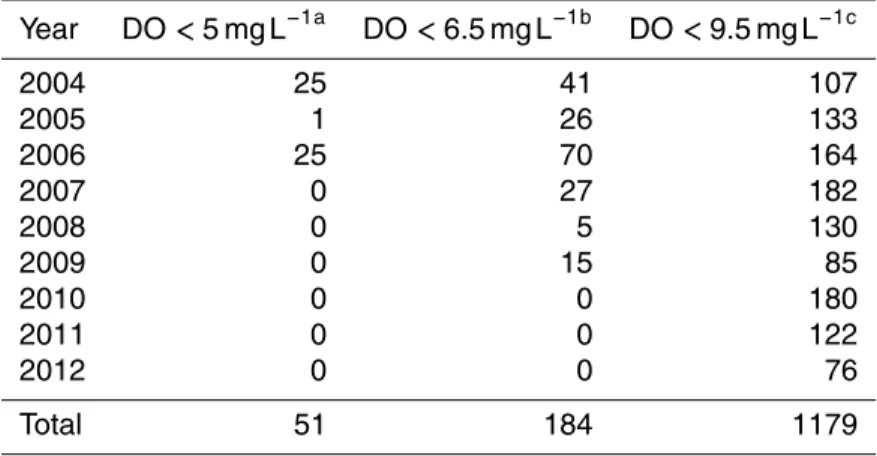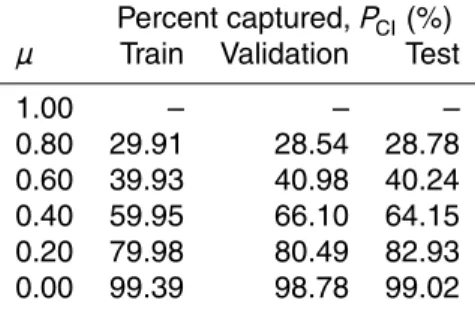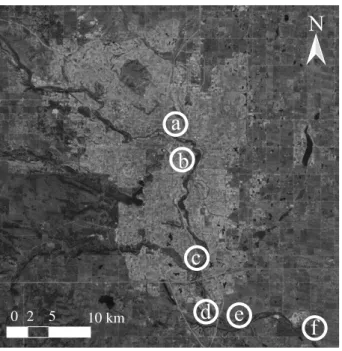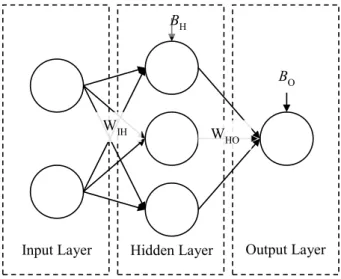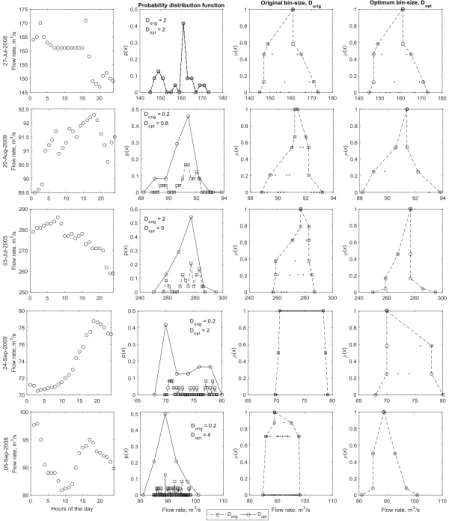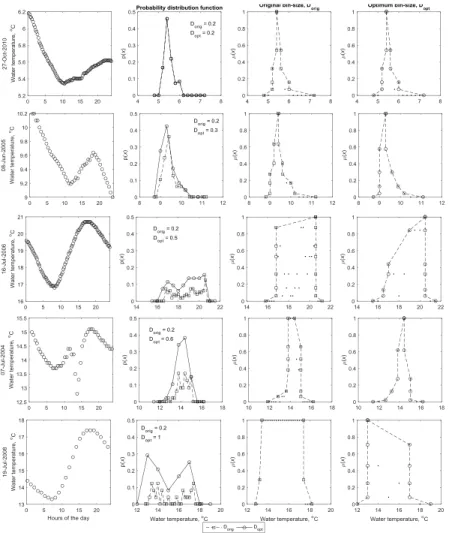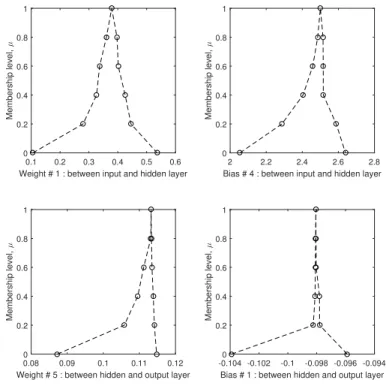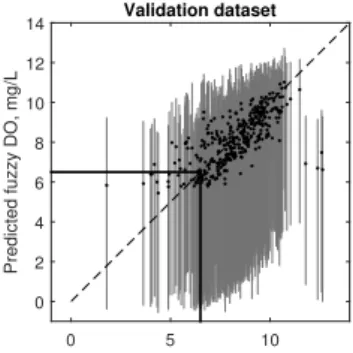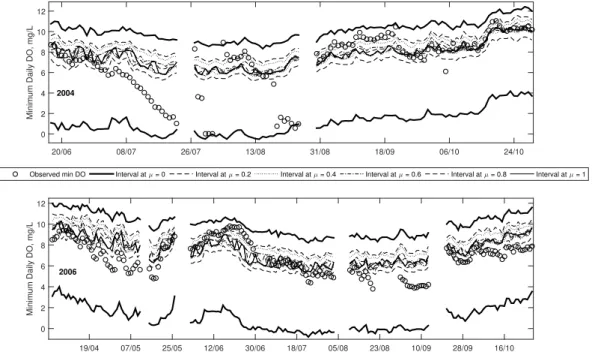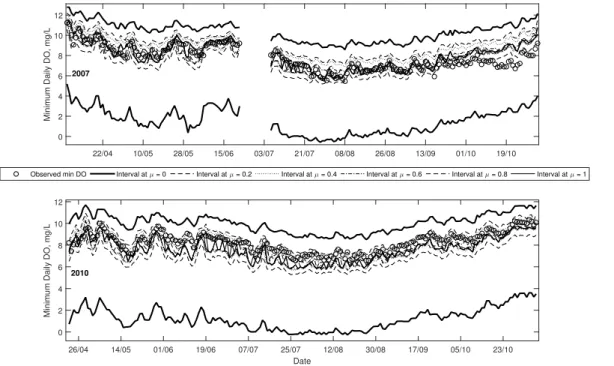HESSD
12, 12311–12376, 2015Dissolved oxygen prediction using a possibility-theory based fuzzy neural
network
U. T. Khan and C. Valeo
Title Page
Abstract Introduction
Conclusions References
Tables Figures
◭ ◮
◭ ◮
Back Close
Full Screen / Esc
Printer-friendly Version
Interactive Discussion
Discussion
P
a
per
|
Discussion
P
a
per
|
Discussion
P
a
per
|
Discussion
P
a
per
|
Hydrol. Earth Syst. Sci. Discuss., 12, 12311–12376, 2015 www.hydrol-earth-syst-sci-discuss.net/12/12311/2015/ doi:10.5194/hessd-12-12311-2015
© Author(s) 2015. CC Attribution 3.0 License.
This discussion paper is/has been under review for the journal Hydrology and Earth System Sciences (HESS). Please refer to the corresponding final paper in HESS if available.
Dissolved oxygen prediction using a
possibility-theory based fuzzy neural
network
U. T. Khan and C. Valeo
Mechanical Engineering, University of Victoria, P.O. Box 1700, Stn. CSC, Victoria, BC, V8W 2Y2, Canada
Received: 16 October 2015 – Accepted: 13 November 2015 – Published: 26 November 2015
Correspondence to: C. Valeo (valeo@uvic.ca)
HESSD
12, 12311–12376, 2015Dissolved oxygen prediction using a possibility-theory based fuzzy neural
network
U. T. Khan and C. Valeo
Title Page
Abstract Introduction
Conclusions References
Tables Figures
◭ ◮
◭ ◮
Back Close
Full Screen / Esc
Printer-friendly Version
Interactive Discussion
Discussion
P
a
per
|
Discussion
P
a
per
|
Discussion
P
a
per
|
Discussion
P
a
per
|
Abstract
A new fuzzy neural network method to predict minimum dissolved oxygen (DO) con-centration in a highly urbanised riverine environment (in Calgary, Canada) is proposed. The method uses abiotic (non-living, physical and chemical attributes) as inputs to the model, since the physical mechanisms governing DO in the river are largely unknown. 5
A new two-step method to construct fuzzy numbers using observations is proposed. Then an existing fuzzy neural network is modified to account for fuzzy number inputs and also uses possibility-theory based intervals to train the network. Results demon-strate that the method is particularly well suited to predict low DO events in the Bow River. Model output and a defuzzification technique is used to estimate the risk of low 10
DO so that water resource managers can implement strategies to prevent the occur-rence of low DO.
1 Introduction
The City of Calgary is a major economic hub in western Canada. With a rapidly growing population, currently estimated in excess of 1 million, the City is undergoing expansion 15
and urbanisation to accommodate the changes. The Bow River is a relatively small river
(with an average annual flow of 90 m3s−1, with an average width of 100 m, and depth
of 1.5 m) that flows through the City and provides approximately 60 % of the residents with potable water (Khan and Valeo, 2015a, b). In addition to this, water is diverted from within the City for irrigation, is used as a source for commercial and recreational 20
fisheries, and is the source of drinking water for communities downstream of Calgary (Robinson et al., 2009; Bow River Basin Council, 2015). This highlights the importance of the Bow River, not just as a source of potable water, but also as a major economic resource.
However, urbanisation has the potential to reduce the health of the Bow River, which 25
HESSD
12, 12311–12376, 2015Dissolved oxygen prediction using a possibility-theory based fuzzy neural
network
U. T. Khan and C. Valeo
Title Page
Abstract Introduction
Conclusions References
Tables Figures
◭ ◮
◭ ◮
Back Close
Full Screen / Esc
Printer-friendly Version
Interactive Discussion
Discussion
P
a
per
|
Discussion
P
a
per
|
Discussion
P
a
per
|
Discussion
P
a
per
|
Alberta (Bow River Basin Council, 2015). Three wastewater treatment plants (shown
in Fig. 1) and numerous stormwater outfalls discharge their effluent into the River and
are considered to be a major cause of water quality degradation in the River (He et al., 2015). This highlights some of the major impacts on the Bow River from the surrounding urban area. A number of municipal and provincial programs are in place to reduce the 5
loading of nutrients and sediments into the river such as the Total Loadings Manage-ment Plan and the Bow River Phosphorus ManageManage-ment Plan (Neupane et al., 2014)
as well as modelling efforts – namely the Bow River Water Quality Model (Tetra Tech,
2013; Golder, 2004) – to predict the impact of different water management programs
on the water quality. 10
One of the major concerns is that low dissolved oxygen (DO) concentration has oc-curred on a number of occasions over the last decade in the Bow River within the City limits. DO is an indicator of overall health of the aquatic ecosystem (Dorfman and Ja-coby, 1972; Hall, 1984; Canadian Council of Ministers of the Environment, 1999; Kan-nel et al., 2007; Khan and Valeo, 2014a, 2015a), and low DO – which can be caused 15
by a number of different factors (Pogue and Anderson, 1995; Hauer and Hill, 2007; He
et al., 2011; Wen et al., 2013) – can impact various organisms in the waterbody. While
the impact of long-term effects of low DO are largely unknown, acute events can have
devastating effects on aquatic ecosystems (Adams et al., 2013). Thus, maintaining
a suitably high DO concentration, and water quality in general, is of utmost importance 20
to the City of Calgary and downstream stakeholders, particularly as the City is being challenged to meet its water quality targets (Robinson et al., 2009).
A number of recent studies have examined the DO in the Bow River, and the factors that impact its concentration. Iwanyshyn et al. (2008) found the diurnal variation in DO and nutrient (nitrate and phosphate) concentration was highly correlated, suggesting 25
stud-HESSD
12, 12311–12376, 2015Dissolved oxygen prediction using a possibility-theory based fuzzy neural
network
U. T. Khan and C. Valeo
Title Page
Abstract Introduction
Conclusions References
Tables Figures
◭ ◮
◭ ◮
Back Close
Full Screen / Esc
Printer-friendly Version
Interactive Discussion
Discussion
P
a
per
|
Discussion
P
a
per
|
Discussion
P
a
per
|
Discussion
P
a
per
|
ies, the seasonality of DO, nutrients, and biological concentration, and external factors (e.g. flood events) were demonstrative of the complexity in understanding river pro-cesses in an urban area, and that consideration of various inputs, outputs and their interaction if important to fully understand the system. He et al. (2011) found that sea-sonal variations in DO in the Bow River could be explained by a combination of abiotic 5
factors (such as climatic and hydrometric conditions), as well as biotic factors. The study found that while photosynthesis and respiration of biota are the main drivers of DO fluctuation, the role of nutrients (from both point and non-point sources) was ambiguous. Neupane et al. (2014) found that organic materials and nutrients from point and non-point sources influence DO concentration in the River. The likelihood 10
of low DO was highest downstream of wastewater treatment plants, and that non-point sources have a significant impact in the open-water season. Using a physically-based model, Neupane et al. (2014) predicted low DO concentration more frequently in the future in the Bow River owing to higher phosphorus concentration in the water, as well as impacts of climate change.
15
A major issue of modelling DO in the Bow River is that rapid urbanisation within the watershed has resulted in substantial changes to land-use characteristics, sediment and nutrient loads, and to other factors that govern DO. Major flood events (like those in 2005 and 2013) completely alter the aquatic ecosystem, while new wastewater treat-ment plants (e.g. the Pine Creek wastewater treattreat-ment plant) added in response to the 20
growing population further increases the stress downstream. These types of changes in a watershed increase the complexity of the system, making DO trends and variability more challenging to model. The interaction of numerous factors, over a relatively small
area and across different temporal scales means that DO trends in urban areas are
more difficult to predict and evaluating water quality in urban riverine environments is
25
a difficult task (Hall, 1984; Niemczynowicz, 1999).
under-HESSD
12, 12311–12376, 2015Dissolved oxygen prediction using a possibility-theory based fuzzy neural
network
U. T. Khan and C. Valeo
Title Page
Abstract Introduction
Conclusions References
Tables Figures
◭ ◮
◭ ◮
Back Close
Full Screen / Esc
Printer-friendly Version
Interactive Discussion
Discussion
P
a
per
|
Discussion
P
a
per
|
Discussion
P
a
per
|
Discussion
P
a
per
|
stood, in a rapidly changing urban environment. Physically-based models require the
parameterisation of a several different variables which may be unavailable, expensive
and time consuming (Antanasijevićet al., 2014; Wen et al., 2013; Khan et al., 2013). In
addition to this, the increase in complexity in an urban system proportionally increases the uncertainty in the system. This uncertainty can arise as a result of vaguely known 5
relationships among all the factors that influence DO, in addition to the inherent ran-domness in the system (Deng et al., 2011). The rapid changes in an urban area render
the systemdynamic as opposed tostationary, which is what is typically assumed for
many probability-based uncertainty quantification methods. Thus, not only is DO
pre-diction difficult, it is beset with uncertainty, hindering water resource managers from
10
making objective decisions.
In this research, we propose a new method to predict DO concentration in the Bow River using a data-driven approach, as opposed to a physically-based method, that
usespossibilitytheory and fuzzy numbers to represent the uncertainty rather than the
more commonly used probability theory. Data-driven models are a class of numer-15
ical models based on generalised relationships, links or connections between input and output datasets (Solomantine and Ostfeld, 2008). These models can characterize a system with limited assumptions and are useful in solving practical problems, espe-cially when there is lack of understanding of the underlying physical process, the time
series are of insufficient length, or when existing models are inadequate (Solomatine
20
et al., 2008; Napolitano et al., 2011).
1.1 Fuzzy numbers and data-driven modelling
Possibility theory is an information theory that is an extension of fuzzy sets theory for
representing uncertain, vague or imprecise information (Zadeh, 1978). Fuzzynumbers
are an extension of fuzzy set theory, and express an uncertain or imprecisequantity.
25
HESSD
12, 12311–12376, 2015Dissolved oxygen prediction using a possibility-theory based fuzzy neural
network
U. T. Khan and C. Valeo
Title Page
Abstract Introduction
Conclusions References
Tables Figures
◭ ◮
◭ ◮
Back Close
Full Screen / Esc
Printer-friendly Version
Interactive Discussion
Discussion
P
a
per
|
Discussion
P
a
per
|
Discussion
P
a
per
|
Discussion
P
a
per
|
exists. This type of uncertainty is in contrast to aleatory uncertainty that is typically handled using probability theory. Possibility theory and fuzzy numbers are thus useful when a probabilistic representation of parameters may not be possible, since the exact values of parameters may be unknown, or only partial information is available (Zhang, 2009). Thus, the choice of using a data-driven approach in combination with possibility 5
theory lends itself well to the constraints posed by the problem in the Bow River: the
difficulty in correctly defining a physically-based model for a complex urban system and
the use of possibility theory to model the uncertainty in the system when probability theory based methods may be inadequate.
Data-driven models, such as neural networks, regression-based techniques, fuzzy 10
rule–based systems, and genetic programming, have seen widespread use in hydrol-ogy, including DO prediction in rivers (Shrestha and Solomatine, 2008; Solomatine et al., 2008; Elshorbagy et al., 2010). Wen et al. (2011) used artificial neural networks (ANN) to predict DO in a river in China using ion concentration as the predictors.
An-tanasijević et al. (2014) used ANNs to predict DO in a river in Serbia using a Monte
15
Carlo approach to quantify the uncertainty in model predictions and temperature as a predictor. Chang et al. (2015) also used ANNs coupled with hydrological factors (such as precipitation and discharge) to predict DO in a river in Taiwan. Singh et al. (2009) used water quality parameters to predict DO and BOD in a river in India. Other stud-ies (e.g. Heddam, 2014; Ay and Kisi, 2012) have used regression to predict DO in 20
rivers using water temperature, or electrical conductivity, amongst others, as inputs. In general, these studies have demonstrated that there is a need and demand for less complex DO models, has led to an increase in the popularity of data-driven models
(An-tanasijevićet al., 2014), and that the performance of these models is suitable. Recent
research into predicting DO concentration in the Bow River in Calgary using abiotic 25
HESSD
12, 12311–12376, 2015Dissolved oxygen prediction using a possibility-theory based fuzzy neural
network
U. T. Khan and C. Valeo
Title Page
Abstract Introduction
Conclusions References
Tables Figures
◭ ◮
◭ ◮
Back Close
Full Screen / Esc
Printer-friendly Version
Interactive Discussion
Discussion
P
a
per
|
Discussion
P
a
per
|
Discussion
P
a
per
|
Discussion
P
a
per
|
the factors (e.g. increasing the discharge rate downstream of a treatment plant) can potentially reduce the risk of low DO.
While fuzzy set theory based applications, particularly applications using fuzzylogic
in neural networks, have been widely used in many fields including hydrology
(Bár-dossy et al., 2006; Abrahart et al., 2010), the use of fuzzynumbersand possibility
the-5
ory based applications has been limited in comparison (Bárdossy et al., 2006; Jacquin, 2010). Some examples include maps of soil hydrological properties (Martin-Clouaire et al., 2000), remotely sensed soil moisture data (Verhoest et al., 2007), climate mod-elling (Mujumdar and Ghosh, 2008), subsurface contaminant transport (Zhang et al., 2009), and streamflow forecasting (Alvisi and Franchini, 2011). Khan et al. (2013) and 10
Khan and Valeo (2015a) have introduced a fuzzy number basedregressiontechnique
to model daily DO in the Bow River using abiotic factors with promising results. Sim-ilarly, Khan and Valeo (2014a) used an autoregressive time series based approach combined with fuzzy numbers to predict DO in the Bow River. In these studies the use of fuzzy numbers meant that the uncertainty in the system could be quantified 15
and propagated through the model. However, due to the highly non-linear nature of DO modelling, the use of an ANN based method is of interest since these types of
models are effective for modelling complex, nonlinear relationships without the explicit
understanding of the physical phenomenon governing the system. A fuzzy neural net-work method proposed by Alvisi and Franchini (2011) for streamflow prediction that 20
uses fuzzy weights and biases in the network, is further refined in this research for predicting DO concentration.
1.2 Objectives
Given the importance of DO concentration as an indicator of overall aquatic ecosys-tem health, there is a need to accurately model and predict DO in urban riverine en-25
Fran-HESSD
12, 12311–12376, 2015Dissolved oxygen prediction using a possibility-theory based fuzzy neural
network
U. T. Khan and C. Valeo
Title Page
Abstract Introduction
Conclusions References
Tables Figures
◭ ◮
◭ ◮
Back Close
Full Screen / Esc
Printer-friendly Version
Interactive Discussion
Discussion
P
a
per
|
Discussion
P
a
per
|
Discussion
P
a
per
|
Discussion
P
a
per
|
chini (2011) is adapted and extended in two critical ways. The existing method uses crisp (i.e. non-fuzzy) inputs and outputs to train the network, producing a set of fuzzy number weights and biases, and fuzzy outputs. The method is adapted to be able to handle fuzzy number inputs to produce fuzzy weights and biases, and fuzzy outputs. The advantage is that the uncertainties in the input observations are also captured 5
within the model structure. To do this, a new method of creating fuzzy numbers from observations is presented based on a probability-possibility transformation. Second, the existing training algorithm is based on capturing a predetermined set of observa-tions (e.g. 100, 95 or 90 %) within the fuzzy outputs. The selection of the predetermined set of observations in the original study was an arbitrary selection. A new method that 10
exploits the relationship between possibility theory and probability theory is defined to create a more objective method of training the FNN. A consequence of this is that the resulting fuzzy number outputs from the model can then be directly used for risk analysis, specifically to quantify the risk of low DO concentration. This information is extremely valuable for managing water resources in the face of uncertainty.
15
Following previous research for this river, two abiotic inputs (daily mean water
tem-perature, T and daily mean flow rate, Q) will be used to predict daily minimum DO.
An advantage of using these factors is that they are routinely collected by the City of Calgary, and thus, a large dataset is available. Also, their use in previous studies has shown that they are good predictors of daily DO concentration in this river basin (He 20
et al., 2011; Khan et al., 2013; Khan and Valeo, 2015a). The following sections outline the background of fuzzy numbers and existing probability-possibility transformations. This is followed by the development of the new method to create fuzzy numbers from observations. Then, the new FNN method using fuzzy inputs is developed mathemat-ically using new criteria for training, also based on possibility theory. Lastly, a method 25
HESSD
12, 12311–12376, 2015Dissolved oxygen prediction using a possibility-theory based fuzzy neural
network
U. T. Khan and C. Valeo
Title Page
Abstract Introduction
Conclusions References
Tables Figures
◭ ◮
◭ ◮
Back Close
Full Screen / Esc
Printer-friendly Version
Interactive Discussion
Discussion
P
a
per
|
Discussion
P
a
per
|
Discussion
P
a
per
|
Discussion
P
a
per
|
2 Methods
2.1 Data collection
The Bow River is 645 km long and averages a 0.4 % slope over its length (Bow River Basin Council, 2015) from its headwaters at Bow Lake in the Rocky Mountains to its confluence with the Oldman River in Southern Alberta, Canada (Robinson et al., 2009; 5
Environment Canada, 2015). The river is supplied by snowmelt from the Rocky Moun-tains, rainfall and discharge from groundwater. The City of Calgary is located within the
Bow River Basin and the river has an average annual discharge of 90 m3s−1, an
aver-age width and depth of 100 and 1.5 m, respectively (Khan and Valeo, 2014b, 2015b). The City of Calgary routinely samples a variety of water quality parameters along 10
the Bow River to measure the impacts of urbanisation, particularly from three
wastew-ater treatment plants and numerous stormwwastew-ater runoffoutfalls that discharge into the
River. DO concentration measured upstream of the City is generally high throughout the year, with little diurnal variation (He et al., 2011; Khan et al., 2013; Khan and Valeo, 2015a). The DO concentration downstream of the City is lower and experiences much 15
higher diurnal fluctuation. The three wastewater treatment plants are located upstream of this monitoring site, and are thought to be responsible, along with other impacts of urbanisation, for the degradation of water quality (He et al., 2015).
For this research, nine years of DO concentration data was collected from one of the downstream stations from 2004 to 2012. The monitoring station was located at 20
Pine Creek and sampled water quality data every 30 min (from 2004 to 2005), and every 15 min (from 2006 to 2007). The station was then moved to Stier’s Ranch and sampled data every hour (in 2008) and every 15 min (2009 to 2011). The monitoring site was moved further downstream to its current location (at Highwood) in 2012 where it samples every 15 min. During this period a number of low DO events have been 25
observed in the River and are summarised below in Table 1 corresponding to different
HESSD
12, 12311–12376, 2015Dissolved oxygen prediction using a possibility-theory based fuzzy neural
network
U. T. Khan and C. Valeo
Title Page
Abstract Introduction
Conclusions References
Tables Figures
◭ ◮
◭ ◮
Back Close
Full Screen / Esc
Printer-friendly Version
Interactive Discussion
Discussion
P
a
per
|
Discussion
P
a
per
|
Discussion
P
a
per
|
Discussion
P
a
per
|
Note that even though daily minimum DO was observed to be below 5 mg L−1on
sev-eral occasions in 2004 and 2006 (in Table 1), the minimum DO was below 9.5 mg L−1
only 107 and 164 days, respectively, for those two years. In contrast, in 2007 and 2010,
no observations below 5 mg L−1 are seen yet 182 and 180 days, respectively, below
the 9.5 mg L−1 guideline were seen for those years. The total amount of days below
5
9.5 mg L−1constitute approximately 90 % of all observations for those years. This
high-lights that despite no DO events below 5 mg L−1, generally speaking minimum DO on
a daily basis was quite low in these two years. The implication of this is that only using one guideline for DO might not be a good indicator of overall aquatic ecosystem health.
A YSI sonde is used to monitor DO andT, and the sonde is not accurate in freezing
10
water, thus only data from the ice free period was considered, which is approximately from April to October for most years (YSI Inc., 2015). Since low DO events usually occur in the summer (corresponding to high water temperature and lower discharge), the ice-free period dataset contains the dates that are of interest for low DO modelling.
Daily mean flow rate,Q, was collected from the Water Survey of Canada site “Bow
15
River at Calgary” (ID: 05BH004) for the same period. This data is collected hourly throughout the year, thus, data where considerable shift corrections were applied (usu-ally due to ice conditions) were removed from the analysis. The mean annual water
temperature ranged between 9.23 and 13.2◦C, and the annual mean flow rate was
between 75 and 146 m3s−1, for the selected period.
20
2.2 Probability-possibility transformations
Fuzzy sets were proposed by Zadeh (1965) in order to express imprecision in complex systems, and can be described as a generalisation of classical set theory (Khan and
Valeo, 2015a). In classical set theory, an elementx either belongs or does not belong
to a set A. In contrast, using fuzzy set theory, the elementsx have a degree of
mem-25
HESSD
12, 12311–12376, 2015Dissolved oxygen prediction using a possibility-theory based fuzzy neural
network
U. T. Khan and C. Valeo
Title Page
Abstract Introduction
Conclusions References
Tables Figures
◭ ◮
◭ ◮
Back Close
Full Screen / Esc
Printer-friendly Version
Interactive Discussion
Discussion
P
a
per
|
Discussion
P
a
per
|
Discussion
P
a
per
|
Discussion
P
a
per
|
A, andµ=1 means that it completely belongs inA, while a valueµ=0.5 means that it
is only a partial member ofA.
Fuzzynumbers express uncertain or imprecisequantities, and represent the set of
all possible values that define a quantity rather than a single value. A fuzzy number is
defined as a specific type of fuzzy set: anormalandconvexfuzzy set. Normal implies
5
that there is at least one element in the fuzzy set with a membership level equal to 1, while convex means that the membership function increases monotonically from
the lower support (i.e., µ=0L) to the modal element (i.e. the element(s) withµ=1)
and then monotonically decreases to the upper support (i.e.,µ=0R) (Kaufmann and
Gupta, 1985). 10
Traditional representation of a fuzzy numbers has been using symmetrical, linear membership functions, typically denoted as triangular fuzzy numbers. The reason for selecting this type of membership function has to do with its simplicity: given that a fuzzy number must, by definition, be convex and normal, a minimum of three
ele-ments are needed to define a fuzzy number (two eleele-ments atµ=0 and one element
15
at µ=1). For example, if the most credible value for DO concentration is 10 mg L−1
(µ=1), with a support about the modal value between (µ=0L) and 12 mg L−1(µ=0R).
This implies that the simplest membership function is triangular, though not necessar-ily symmetrical. Also, as we demonstrate below, in some probability-possibility frame-works, a triangular membership function corresponds to a uniform probability distribu-20
tion – the least specific distribution in that any value is equally probable and hence, represents the most uncertainty (Dubois and Prade, 2015; Dubois et al., 2004).
However, recent research (Khan et al., 2013; Khan and Valeo, 2014a, b, 2015a, b) has shown that such a simplistic representation may not be appropriate for hydrological data, which is often skewed, and non-linear. This issue is further highlighted if the 25
probability-possibility framework mentioned above is used: it implies that for a triangular
membership function, the fuzzy number bounded by the support [8 12] mg L−1, has
a uniform probability distribution bounded between 8 and 12 mg L−1with a mean value
HESSD
12, 12311–12376, 2015Dissolved oxygen prediction using a possibility-theory based fuzzy neural
network
U. T. Khan and C. Valeo
Title Page
Abstract Introduction
Conclusions References
Tables Figures
◭ ◮
◭ ◮
Back Close
Full Screen / Esc
Printer-friendly Version
Interactive Discussion
Discussion
P
a
per
|
Discussion
P
a
per
|
Discussion
P
a
per
|
Discussion
P
a
per
|
not difficult to see that this an over-simplification of hydrological data, which often have
skewed, non-symmetrical distributions. In many cases enough information (i.e. from observations) is available to define the membership function with more specificity, and this information should be used to define the membership function.
Multiple frameworks exist to transform a probability distribution to a possibility distri-5
bution, and vice versa; a comparison of different conceptual approaches are provided
in Klir and Parvais (1992), Oussalah (2000), Jaquin (2010), Mauris (2013) and Dubois and Prade (2015). However, a major issue of implementing fuzzy number based meth-ods in hydrology is that there is no consistent, transparent and objective method to convert observations (e.g. time series data) into fuzzy numbers, or generally speak-10
ing to construct the membership function associated with fuzzy values (Abrahart et al., 2010; Dubois and Prade, 1993; Civanlar and Trussel, 1986).
A popular method (Dubois et al., 1993, 2004) converts a probability distribution to a possibility distribution by relating the area under a probability density function to the membership level (Zhang, 2009). From this point of view, the possibility is viewed as 15
the upper envelope of the family of probability measures (Jacquin, 2010; Ferrero et al., 2013; Betrie et al., 2014). There are two important considerations for this transforma-tion, first it guarantees that something must be possible before it is probable; hence, the degree of possibility cannot be less than the degree or probability – this is known as the consistency principle (Zadeh, 1965). Second is order preservation, which means if 20
the possibility ofxi is greater than the possibility ofxj then the probability ofxi must be
greater than the probability ofxj (Dubois et al., 2004). For a discrete system, this can
be represented as:
ifp(x1)> p(x2)> . . . > p(xn),
then the possibility distribution ofx (π(x)), follows the same order, that is: 25
π(x1)> π(x2)> . . . > π(xn).
HESSD
12, 12311–12376, 2015Dissolved oxygen prediction using a possibility-theory based fuzzy neural
network
U. T. Khan and C. Valeo
Title Page
Abstract Introduction
Conclusions References
Tables Figures
◭ ◮
◭ ◮
Back Close
Full Screen / Esc
Printer-friendly Version
Interactive Discussion
Discussion
P
a
per
|
Discussion
P
a
per
|
Discussion
P
a
per
|
Discussion
P
a
per
|
Forp(x1)> p(x2)> . . . > p(xn):
π(x1)=1
f(x)=
(Pn
j=ipj, ifpi−1> pi
π(xi−1), else
(1)
where the xi are elements of a fuzzy number A, π(xi) is the possibility of element
xi, and p(xi) is the probability of elementxi. The concept of this transformation may
5
be more illustrative when viewed in the continuous case: for any interval [a,b], the
membership levelµ(whereπ(a)=π(b)=µ) is equal to the sum of the areas under the
probability density function curve between (−∞,a) and (b,∞) (Zhang et al., 2009). It is
important to highlight that this particular transformation has an inverse transformation associated with, where a probability distribution can be estimated from the possibility 10
distribution.
However, a major drawback of this transformation is that it theoretically requires a full description of the probability density function, or in the finite case, the probability asso-ciated with each element of the fuzzy number, the probability mass function. For many hydrology and time series based applications this might not be possible because the 15
hourly data (that is typically collected) may not adequately fit the mould of a known class of probability density functions, or one distribution amongst many alternatives may have to be selected based on best-fit. This best-fit function may not be univer-sal, e.g. data from one 24 h period may be best described by one class or family of
probability density function, while the next day by a completely different class of
den-20
sity function. This means working with multiple classes of distribution functions for one application, which can be cumbersome. Also, given that each day may only have 24
data points (or fewer on days with missed samples) it is difficult to select one particular
function.
In previous research by Khan and Valeo (2015a), a new approach to create a fuzzy 25
HESSD
12, 12311–12376, 2015Dissolved oxygen prediction using a possibility-theory based fuzzy neural
network
U. T. Khan and C. Valeo
Title Page
Abstract Introduction
Conclusions References
Tables Figures
◭ ◮
◭ ◮
Back Close
Full Screen / Esc
Printer-friendly Version
Interactive Discussion
Discussion
P
a
per
|
Discussion
P
a
per
|
Discussion
P
a
per
|
Discussion
P
a
per
|
was used to estimate the membership function of the fuzzy number. To create the his-togram, the bin-size was selected based on the extrema observations for a given day and the number of the observations. A linear interpolation scheme was then used to calculate the values of the fuzzy number at five predefined membership levels. This method has a few short-comings, namely: the bin-size selection was arbitrarily selected 5
based on the magnitude and number of observations which does not necessarily result in the optimum bin-size. This lack of optimality means that the resulting histogram may either be too smooth so as not to capture the variability between membership levels, or too rough and uneven so that the underlying shape of the membership function is
difficult to discern. This is a common issue with histogram selection in many
applica-10
tions (Shimazaki and Shinomoto, 2007). Secondly, the aforementioned transformation
used by Khan and Valeo (2015a) only allows one element to have µ=1 when p(x)
is maximum. However, there are a number of cases (e.g. bimodal distributions, or ar-rays when all elements are equal) where multiple elements have joint-equal maximum
p(x)), and hence multiple elements withµ=1. This means that all elementswithinthe
15
α-cut interval [a b]µ=1 (wherea and b are the minimum and maximum elements with
µ=1) must by definition also have a membership level equal to 1. Thus, a method is
necessary to be flexible enough to accommodate these types of issues.
In this research, a two-step procedure is proposed to create fuzzy numbers on the
inputs (i.e.Q and T) using hourly (or sub-hourly) observations. First, a bin-size
opti-20
misation method is used (an extension of an algorithm proposed by Shimazaki and Shinomoto, 2007) to create histograms to represent the estimate of discretised proba-bility density functions of the observations. This estimate of the probaproba-bility distribution is then transformed to the membership function of the fuzzy number using a new nu-merical procedure and the transformation principles described in Eq. (1). This updated 25
method requires no assumptions regarding the distribution of the underlying data or
selection of an arbitrary bin-size, has the flexibility to create different shapes of fuzzy
el-HESSD
12, 12311–12376, 2015Dissolved oxygen prediction using a possibility-theory based fuzzy neural
network
U. T. Khan and C. Valeo
Title Page
Abstract Introduction
Conclusions References
Tables Figures
◭ ◮
◭ ◮
Back Close
Full Screen / Esc
Printer-friendly Version
Interactive Discussion
Discussion
P
a
per
|
Discussion
P
a
per
|
Discussion
P
a
per
|
Discussion
P
a
per
|
ements to have equal µ=1. The proposed algorithm is described in the proceeding
section.
A new algorithm to create fuzzy numbers
Shimazaki and Shinomoto (2007) proposed a method to find the optimum bin-size of a histogram when the underlying distribution of the process is unknown. The basic 5
premise of the method is that the optimum bin-size (Dopt) is one that minimises the
error between the theoretical (but unknown) probability density and the histogram
gen-erated using theDopt. The error metric used by Shimazaki and Shinomoto (2007) is the
mean integrated squared error (EMISE) which is frequently used for density estimation
problems. It is defined as: 10
EMISE=
1
P
P
Z
0
E[fn(t)−f(t)]2dt (2)
wheref(t) is the unknown density function,fn(t) is the histogram estimate of the density
function,t denotes time and P is the observation period, andE[·] is the expectation.
In practice,EMISE cannot be directly calculated since the underlying distribution is
un-known and thus, an estimate of theEMISE is used in its place (see CD below). Thus,
15
fn(t) can be found without any assumptions of the type of distribution (e.g. class,
uni-modality, etc.); the only assumption is that the number of events (i.e. the countski) in
theith bin of the histogram follow a Poisson point process. This means that the events
in two disjoint bins (e.g. theith and i+1th bin) are independent, and that mean (k)
and variance (v) of the ki in each bin are equal, due to the assumption of a Poisson
20
process (Shimazaki and Shinomoto, 2007).
Using this property, the optimum bin-size can be found as follows. LetXbe the input
data vector for the observation period (P), e.g., a [24×1] vector corresponding to hourly
HESSD
12, 12311–12376, 2015Dissolved oxygen prediction using a possibility-theory based fuzzy neural
network
U. T. Khan and C. Valeo
Title Page
Abstract Introduction
Conclusions References
Tables Figures
◭ ◮
◭ ◮
Back Close
Full Screen / Esc
Printer-friendly Version
Interactive Discussion
Discussion
P
a
per
|
Discussion
P
a
per
|
Discussion
P
a
per
|
Discussion
P
a
per
|
D. The number of events ki in each ith bin are then counted and the mean (k) and
variance (v) of theki are calculated as follows:
k= 1
N
N
X
i=1
ki (3)
v= 1
N
N
X
i=1
(ki−k)2. (4)
Thek andv are then used to compute thecost-functionCD, which is defined as:
5
CD=2k−v
D2 . (5)
This cost-function is a variant of the originalEMISE listed in Eq. (2) and is derived by
removing the terms fromEMISEthat are independent of the bin-sizeD, and by replacing
the unobservable quantities (i.e.E[f(t)]) with their unbiased estimators (details of this
derivation can be found in the original paper by Shimazaki and Shinomoto, 2007). 10
The objective then is to search forDopt: the value of D that minimisesCD. To do this
two systematic modification are made: first,CD is recalculated at different partitioning
positions, and secondly, the entire process is repeated for different values of N and
D, until a “reliable” estimate of minimum CD and thus Dopt is found. Using different
partitioning positions means that the variability inki resulting from the position of the
15
bin (rather than the size of the bin) can be quantified. Repeating the analysis at different
N and D accounts for the variability due to different bin-sizes. Both these techniques
are ways of accounting for the uncertainty associated with estimating the histogram. Partitioning positions are defined as the first and last point that define a bin. The most
common way of defining a partitioning position is to centre it on some valuea, e.g. the
20
bin defined at [a−D/2,a+D/2] is centred on a and has a bin-size D. Variations of
HESSD
12, 12311–12376, 2015Dissolved oxygen prediction using a possibility-theory based fuzzy neural
network
U. T. Khan and C. Valeo
Title Page
Abstract Introduction
Conclusions References
Tables Figures
◭ ◮
◭ ◮
Back Close
Full Screen / Esc
Printer-friendly Version
Interactive Discussion
Discussion
P
a
per
|
Discussion
P
a
per
|
Discussion
P
a
per
|
Discussion
P
a
per
|
bin-sizeDis kept constant, but the first and last points are perturbed by a small value
δ: [a−D/2+δ,a+D/2+δ], where δ ranges incrementally between 0 andD. Using
these different values ofδwhilst keepingDconstant will result in different values ofk
i
and hence unique values ofCD. Thus, for a single value ofD, multiple values ofCDare
possible. 5
For this research this bin-size optimisation algorithm is implemented to determine the
optimum histogram for the two input variables,Qand T. The array of daily data,X, (at
hourly or higher frequency, see Sect. 2.1 for details regarding the sampling frequency of both inputs) for each variable was collected for the nine year period. The bin-size was calculated for each day as follows:
10
D=xmax−xmin
N (6)
where thexmaxandxminare the maximum and minimum sampled values forX,
respec-tively, andN is the number of bins. As described above, a number of differentD were
considered to find the optimumCD. This was done by selecting a number of different
values ofN, ranging from Nmin toNmax. The minimum valueNmin, was set at 3 for all
15
days; this is the necessary number of bins to define a fuzzy number (two elements for
µ=0, and one element forµ=1). The highest value,Nmaxwas calculated as:
N=xmax−xmin
2r (7)
where 2r is the measurement resolution of the device used to measure eitherQorT,
set at twice the accuracy (r) of the device. The rational for this decision is that asN
20
increases D necessarily decreases (as per Eq. 6). However, D cannot be less than
the measurement resolution; this constraint (i.e.N≤Nmax) ensures that the optimum
bin-size is never less than what the measurement devices can physically measure. For
this research, the accuracy forT is listed as ±0.1◦C, and thus, the resolution (2r) is
0.2◦C (YSI Inc., 2015). ForQall measurements below 99 m3s−1have an accuracy of
HESSD
12, 12311–12376, 2015Dissolved oxygen prediction using a possibility-theory based fuzzy neural
network
U. T. Khan and C. Valeo
Title Page
Abstract Introduction
Conclusions References
Tables Figures
◭ ◮
◭ ◮
Back Close
Full Screen / Esc
Printer-friendly Version
Interactive Discussion
Discussion
P
a
per
|
Discussion
P
a
per
|
Discussion
P
a
per
|
Discussion
P
a
per
|
±0.1 m3s−1and thus, a resolution of 0.2 m3s−1, while measurements above 99 m3s−1
have an accuracy of ±1 m3s−1, and thus a resolution of 2 m3s−1. This is based on
the fact that all data provided by the Water Survey of Canada is accurate to three
significant figures. Note that for the case wherexmin equals xmax (i.e. no variance in
the daily observed data) thenD=2r, which means that the only uncertainty considered
5
is due to the measurement.
Once theNmaxis determined, the bin-sizeDwas calculated for eachNbetweenNmin
andNmax. Then, starting at the largestD(i.e.D=(xmax−xmin)/Nmin), the cost-function
CD is calculated at the firstpartitioning positing, where the first bin is centred atxmin,
[(xmin−D/2)(xmin+D/2)], and the Nth bin is centred on xmax, [(xmax−D/2), (xmax+
10
D/2)]. Then, CD is calculated at the next partitioning positing, where the first bin is
[(xmin−D/2+δ)(xmin+D/2+δ)], and theNth bin is [(xmax−D/2+δ), (xmax+D/2+δ)].
The value ofδranged between 0 andDat (D/100) intervals. Thus, for this value ofD,
100 values ofCD were calculated since 100 different partitioning positions were used.
The mean value of these CD was used to define the final cost-function value for the
15
givenD.
This process is then repeated for the next N between Nmin and Nmax, using the
correspondingD at 100 different partitioning positions, and so on until the smallest D
(atNmax). This results in [Nmax−Nmin] values of meanCD: the value ofDcorresponding
to the minimum value ofCDis considered to be the optimum bin-sizeDopt. ThisDoptis
20
then used to construct the optimum histogram of each daily observation. This histogram
can be used to calculate a discretised probability density function (p(x)), where for each
x(an element ofX), thep(x) is calculated by dividing the number of events in each bin
by the total number of elements inX. Thexandp(x) can then be used to calculate the
possibility distribution using the transformation described in Eq. (1). 25
First, the p(x) are ranked from highest to lowest, and the x corresponding to the
highestp(x) is has a membership level of 1. Then the π(x) values for the remaining
x are calculated using Eq. (1). For cases where multiple elements have equal p(x),
the highestπ(x) is assigned to eachx. For example, ifp(xi)=p(x
HESSD
12, 12311–12376, 2015Dissolved oxygen prediction using a possibility-theory based fuzzy neural
network
U. T. Khan and C. Valeo
Title Page
Abstract Introduction
Conclusions References
Tables Figures
◭ ◮
◭ ◮
Back Close
Full Screen / Esc
Printer-friendly Version
Interactive Discussion
Discussion
P
a
per
|
Discussion
P
a
per
|
Discussion
P
a
per
|
Discussion
P
a
per
|
π(xj)=π(xi). This means that in some cases, for each calculated membership level,
π(x), there exists anα-cut interval [a,b]µ=π(x)where all the elements betweenaandb
have equalp(x) and hence equalπ(x). By definition of α-cut intervals, all values ofx
within the interval [a,b] haveat leasta possibility ofπ(x). A special case of this occurs
when multiplex have joint-equal maximump(x), meaning that multiple elements have
5
a membership level of µ=1. Thus, an α-cut interval is created for the µ=1 case,
creating a trapezoidal membership function, where the modal value of the fuzzy number is defined by an interval rather than a single element.
Once all the π(x) are calculated for each element x in X, a discretised empirical
membership function of the fuzzy numberX can be constructed using the calculated
10
α-cut intervals. That is, the fuzzy number is defined by a number of intervals at different
membership levels. The upper and lower limit of the intervals at higher membership levels define the extent of the limits of the intervals at lower membership levels. This way the constructed fuzzy numbers maintain convexity (similar to a procedure used by Alvisi and Franchini, 2011), where the widest intervals have the lowest membership 15
level. For example, the interval at µ=0.2 will contain the interval µ=0.4, and this
interval will contain the interval atµ=0.8.
In creating this discretised empirical membership function this way (rather than as-suming a shape of the function) means that this function best reflects the possibility distribution of the observed data. However, it also means that all fuzzy numbers cre-20
ated using this method are not guaranteed to be defined at the sameπ(x), nor have
an equal number ofπ(x) intervals used to define the fuzzy number. Thus, direct fuzzy
arithmetic between multiple fuzzy numbers using the extension principle is not possible
since it requires each fuzzy number to be defined at the sameα-cut intervals
(Kauf-mann and Gupta, 1985). Thus, linear interpolation is used to define each fuzzy number 25
at a pre-setα-cut interval using the empiricalπ(x) calculated using the transformation.
To select the pre-setα-cut intervals it is illustrative to see the impact of selecting two
extreme cases: (i) if only two levels are selected (specifically µ=0 and 1) the
HESSD
12, 12311–12376, 2015Dissolved oxygen prediction using a possibility-theory based fuzzy neural
network
U. T. Khan and C. Valeo
Title Page
Abstract Introduction
Conclusions References
Tables Figures
◭ ◮
◭ ◮
Back Close
Full Screen / Esc
Printer-friendly Version
Interactive Discussion
Discussion
P
a
per
|
Discussion
P
a
per
|
Discussion
P
a
per
|
Discussion
P
a
per
|
there are important implications of using triangular membership functions that make it undesirable for hydrological data, (ii) if a large number of intervals (e.g. 100 intervals
betweenµ=0 and 1) are selected, there is a risk that the number of pre-set intervals
is much larger than the empiricalπ(x), which means not enough data (empiricalα-cut
levels intervals) to conduct interpolation, leading to equal interpolated values at mul-5
tipleα-cut levels. For this research, results (discussed in the following section) of the
bin-size optimisation showed that most daily observations for T and Q resulted in 2
to 10 uniquep(x) values. Based on this, six pre-set α-cut intervals were selected: 0,
0.2, 0.4, 0.6, 0.8 and 1. The empirical π(x) can then be converted to a standardised
function at pre-defined membership levels using linear interpolation. 10
2.3 Fuzzy neural networks
2.3.1 Background on artificial neural networks
Artificial neural networks (ANN) are a type of data-driven model that are defined as a massively parallel distributed information processing system (Elshorbagy et al., 2010; Wen et al., 2013). As a predictive model, ANNs can capture complex, nonlinear rela-15
tionships that may exist between variables without the explicit understanding of the
physical phenomenon (Alvisi and Franchini, 2011; Antanasijevićet al., 2014). This has
resulted in significant use of ANN models in hydrology when the complexity of the phys-ical systems is high owing partially to an incomplete understanding of the underlying process, and the lack of availability of necessary data (He et al., 2011; Kasiviswanathan 20
et al., 2013). Further, ANNs arguably require less data and do not require an
ex-plicit mathematical description of the underlying physical process (Antanasijevićet al.,
2014), making it a simpler and practical alternative to traditional modelling techniques. Multilayer Perceptron (MLP) is a type of feedforward ANN and is one of the most commonly used in hydrology (Maier et al., 2010). One of the reasons for the popu-25
HESSD
12, 12311–12376, 2015Dissolved oxygen prediction using a possibility-theory based fuzzy neural
network
U. T. Khan and C. Valeo
Title Page
Abstract Introduction
Conclusions References
Tables Figures
◭ ◮
◭ ◮
Back Close
Full Screen / Esc
Printer-friendly Version
Interactive Discussion
Discussion
P
a
per
|
Discussion
P
a
per
|
Discussion
P
a
per
|
Discussion
P
a
per
|
simple to develop, and theoretically have the capacity of approximating any linear or nonlinear mapping (ASCE 2000; Elshorbagy et al., 2010; Napolitano et al., 2011; Ka-siviswanathan et al., 2013). Further, the popularity of MLP has meant that subsequent research has continued to use MLP (He and Valeo, 2009; Napolitano et al., 2011) and thus, form a reference for the basis of comparing ANN performance (Alvisi and Fran-5
chini, 2011).
In the simplest case, an MLP consists of an input layer, a hidden layer, and an output layer as shown in Fig. 2. Each layer consists of a number of neurons (or nodes) that each receive a signal, and on the basis of the strength of the signal, emit an output. Thus, the final output layer is the synthesis and transformation of all the input signals 10
from both the input and the hidden layer (He and Valeo, 2009).
The number of neurons in the input (nI) and output (nO) layers corresponds to the
number of variables used as the input and the output, respectively and the number
of neurons in the hidden layer (nH) are selected based on the relative complexity of
the system (Elshorbagy et al., 2010). A typical MLP is expressed mathematically as 15
follows:
yi=f
HID(WIHxi+BH) (8)
zi =f
OUT(WHOyi+BO) (9)
wherexi is theith observation (annI×1 vector) from of a total ofnobservations,WIHis
anH×nImatrix of weights between the input and hidden-layer,BHis a vector (nH×1) of
20
biases in the hidden-layer, andyi is theith output (annH×1 vector) of the input signal
through the hidden-layer transfer function,fHID. Similarly,WHOis an nO×nH matrix of
weights between the hidden and output-layers,BO is annO×1 vector of biases in the
output-layer, andfOUT the final transfer function to generate theith modelled outputzi
(annO×1 vector).
25
The values of all the weights and biases in the MLP are calculated by training the
network by minimising the error – typically mean squared error (EMSE) (He and Valeo,
num-HESSD
12, 12311–12376, 2015Dissolved oxygen prediction using a possibility-theory based fuzzy neural
network
U. T. Khan and C. Valeo
Title Page
Abstract Introduction
Conclusions References
Tables Figures
◭ ◮
◭ ◮
Back Close
Full Screen / Esc
Printer-friendly Version
Interactive Discussion
Discussion
P
a
per
|
Discussion
P
a
per
|
Discussion
P
a
per
|
Discussion
P
a
per
|
ber of training algorithms can be used, and one of the most common methods is the Levenberg–Marquardt algorithm (LMA) (Alvisi et al., 2006). In this method, the error between the output and target is back-propagated through the model using a gradient method where the weights and biases are adjusted in the direction of maximum error reduction. The LMA is well-suited for ANN problems that have a relatively small number 5
of neurons. To counteract potential over-fitting issues, an early-stopping procedure is used (Alvisi et al., 2006; Maier et al., 2010), which is a form of regularisation where the data is split into three subsets (for training, validation and testing) and the train-ing is terminated when the error on the validation subset increases from the previous iteration. Most ANNs have a deterministic structure without a quantification of the un-10
certainty corresponding to the predictions (Alvisi and Franchini, 2012; Kasiviswanathan and Sudheer, 2013). This means that users of these models may have excessive con-fidence in the forecasted values, and misinterpret the applicability of the results (Alvisi and Franchini, 2011). This lack of uncertainty quantification is one reason for the limited appeal of ANN by water resource managers (Abrahart et al., 2012; Maier et al., 2010). 15
Without this characterisation, the results produced by these models have limited value (Kasiviswanathan and Sudheer, 2013).
In this research, two methods are proposed to quantify the uncertainty in MLP mod-elling to predict DO in the Bow River. First, the uncertainty in the input data (daily mean water temperature and daily mean flow rate) is represented through the use of fuzzy 20
numbers. These fuzzy numbers are created using the probability-possibility
transfor-mation discussed in the previous section. Second, thetotal uncertainty(as defined by
Alvisi and Franchini, 2011) in the weights and biases of an MLP are quantified using a new possibility theory-based FNN. The total uncertainty represents the overall uncer-tainty in the modelling process, and not of the individual components (e.g. randomness 25
HESSD
12, 12311–12376, 2015Dissolved oxygen prediction using a possibility-theory based fuzzy neural
network
U. T. Khan and C. Valeo
Title Page
Abstract Introduction
Conclusions References
Tables Figures
◭ ◮
◭ ◮
Back Close
Full Screen / Esc
Printer-friendly Version
Interactive Discussion
Discussion
P
a
per
|
Discussion
P
a
per
|
Discussion
P
a
per
|
Discussion
P
a
per
|
2.3.2 FNN with fuzzy inputs and possibility-based intervals
Alvisi and Franchini (2011) proposed a method to create a FNN, where the weights and biases, and by extension the output, of the neural network are fuzzy numbers rather than crisp (non-fuzzy) numbers. These fuzzy numbers quantify the total uncertainty of the calibrated parameters. While fuzzy set theory based applications of ANN have 5
been limited in hydrology, most have used fuzzy logic, e.g. the widely used Adaptive Neuro-Fuzzy Inference System, where automated IF-THEN rules are used to create crisp outputs (Abrahart et al., 2010; Alvisi and Franchini, 2011). Thus, the advantage of fuzzy outputs is that it provides the uncertainty of the predictions as well, while the fuzzy parameters reflect the uncertainty in the model structure. This uncertainty 10
quantification can be used to by end users to assess the value of the model output. In their FNN, the MLP model is presented in Eqs. (5) and (6) is modified to predict an interval rather than a single value for the weights, biases and output, corresponding to
anα-cut interval (at a defined membership levelµ). This is repeated for severalα-cut
levels, thus building a discretised fuzzy number at a number of membership levels. This 15
is done by using a stepwise, constrained optimisation approach:
h
yLiyUi i=fHIDhWL
IHW U IH
i
xi+hBL
HB U H
i
(10)
h
zLizUi i=fOUThWL
HOW U HO
i
×hyLiyUi i+hBL
OB U O
i
(11)
where all the variables are as described as before, and the superscripts “U” and “L”
represent the upper and lower limits of theα-cut interval, respectively. The constraints
20
HESSD
12, 12311–12376, 2015Dissolved oxygen prediction using a possibility-theory based fuzzy neural
network
U. T. Khan and C. Valeo
Title Page Abstract Introduction Conclusions References Tables Figures ◭ ◮ ◭ ◮ Back Close
Full Screen / Esc
Printer-friendly Version Interactive Discussion Discussion P a per | Discussion P a per | Discussion P a per | Discussion P a per | min n X
i=1
zLi −zUi !
1
n
n
X
i=1
(δi)> PCI (12)
δi =
(
1, ifzLi < ti <z U i
0, otherwise
wheretis that target (observed data) andPCIis a predefined percentage of data. Alvisi
and Franchini (2011) definedP to be 100 % atµ=0, 99 % atµ=0.25, 95 % atµ=0.5
5
and 90 % atµ=0.75. This algorithm was built starting atµ=0 and moving to higher
membership levels to maintain convex membership functions of the generated fuzzy numbers by using the results of the previous optimisation as the upper and lower limit
constraints for the proceeding optimisation. Lastly, at µ=1, the interval collapses to
a singleton, represent the crisp results from non-fuzzy ANN. Therefore, these α-cut
10
intervals of the FNN output quantify the uncertainty around the crisp prediction, within
which is expected to containPCIpercentage of data.
In this research, this method is modified in two ways. First, the inputs x are also
fuzzy numbers, which means that Eqs. (10) and (11) are revised as follows:
h yL iy U i i
=fHIDhWL
IHW U IH
i ×hxL
ix U i
i
+hBL
HB U H i (13) 15 h
zLizUi i=f
OUT
h
WLHOWUHOi×hyLiyUi i+hBL
OB U O
i
. (14)
Note that now the input vector is represented by its upper and lower limits. The ma-jor impact on this is that the training algorithm for the FNN needs to accommodate
this fuzzy α-cut interval, which requires the implementation of fuzzy arithmetic
prin-ciples (Kaufmann and Gupta, 1985). The cost function for the optimisation remains 20
HESSD
12, 12311–12376, 2015Dissolved oxygen prediction using a possibility-theory based fuzzy neural
network
U. T. Khan and C. Valeo
Title Page
Abstract Introduction
Conclusions References
Tables Figures
◭ ◮
◭ ◮
Back Close
Full Screen / Esc
Printer-friendly Version
Interactive Discussion
Discussion
P
a
per
|
Discussion
P
a
per
|
Discussion
P
a
per
|
Discussion
P
a
per
|
The second modification of the original algorithm is related to the selection of the
percent of data included in the predicted interval (PCI). In the original, the selection
is arbitrary and end-users of this method may be interested in the events that are
not included in the selected PCI. Thus, a full spectrum of possible values for a given
prediction is required. Thus, the Alvisi and Franchini (2011) approach is further refined 5
by utilising the same relationship between probability and possibility that was used to define the input fuzzy numbers, giving a more objective means of designing FNNs with fuzzy weights, biases and output.
In the adopted possibility-probability framework, the interval [a b]α created by the
α-cut at aµ=αimplies that:
10
[p(x < a)+p(x > b)]=α. (15)
This can be used to calculate the probability:
[p(a < x < b)]=(1−α). (16)
This means that there is a probability of (1−α) that the random variablex falls within
the interval [a b]α. In other words theα-cuts of a possibility distribution (at anyµ)
cor-15
respond to the (1−α) confidence interval of the probability distribution of the same
variable (Serrurier and Prade, 2013). This principle is used to select the differentP for
the optimisation constraints rather than the predeterminedPCI selected by Alvisi and
Franchini (2011) These are shown in Table 2.
Note that for practical purposes, PCI was selected as 99.50 % at µ=0 to prevent
20
over-fitting. The implication of this selection is that at µ=0, nearly-all the observed
data should fall within this predicted FNN interval, reflecting the highest uncertainty
in the prediction. The uncertainty decreases as µincreases. For the µ=1 case the
values of the weights and biases were determined to be the mid-point of the interval
atµ=0.8 to maintain convexity of the produced fuzzy numbers, and the difficulty in
25
